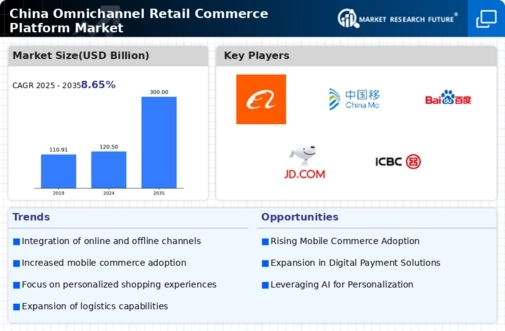Expansion of Mobile Commerce
The expansion of mobile commerce is a pivotal driver in the omnichannel retail-commerce platform market in China. With the proliferation of smartphones and mobile internet access, consumers increasingly prefer shopping via mobile devices. In 2025, mobile commerce is projected to account for over 60% of total e-commerce sales in China, reflecting a significant shift in consumer behavior. Retailers are thus compelled to optimize their platforms for mobile use, ensuring that the shopping experience is seamless across devices. This includes mobile-friendly websites, apps, and payment solutions that cater to the on-the-go consumer. As mobile commerce continues to grow, the omnichannel retail-commerce-platform market must adapt to these trends, focusing on enhancing mobile user experiences to capture a larger share of the market.
Rapid Digital Transformation
the omnichannel retail-commerce platform market in China is experiencing a rapid digital transformation, driven by advancements in technology and changing consumer behaviors. As more consumers embrace online shopping, retailers are compelled to enhance their digital presence. In 2025, it is estimated that e-commerce sales in China will reach approximately $2 trillion, indicating a robust growth trajectory. This shift necessitates the integration of various digital channels, allowing consumers to seamlessly transition between online and offline shopping experiences. Retailers that invest in digital tools and platforms are likely to gain a competitive edge, as they can offer personalized experiences and efficient service. The omnichannel retail-commerce-platform market is thus evolving to meet the demands of a tech-savvy consumer base, which increasingly expects convenience and accessibility in their shopping journeys.
Integration of Social Commerce
The integration of social commerce is emerging as a crucial driver within the omnichannel retail-commerce platform market in China. Social media platforms are increasingly becoming shopping destinations, with consumers discovering and purchasing products directly through these channels. In 2025, it is estimated that social commerce will contribute to approximately 30% of total e-commerce sales in China. This trend encourages retailers to leverage social media for marketing and sales, creating engaging content that drives consumer interaction. By integrating social commerce strategies, brands can enhance their visibility and reach, tapping into the vast user base of social platforms. The omnichannel retail-commerce-platform market is thus evolving to incorporate social elements, allowing for a more interactive and community-driven shopping experience.
Consumer Demand for Personalization
In the context of the omnichannel retail-commerce platform market, there is a growing consumer demand for personalized shopping experiences in China. As consumers become more discerning, they seek tailored recommendations and customized interactions that resonate with their preferences. Data suggests that 80% of consumers are more likely to make a purchase when brands offer personalized experiences. Retailers are responding by leveraging data analytics and artificial intelligence to understand consumer behavior better and deliver targeted marketing strategies. This trend not only enhances customer satisfaction but also drives loyalty, as consumers are more inclined to return to brands that recognize their individual needs. Consequently, the omnichannel retail-commerce-platform market is adapting to these expectations, emphasizing the importance of personalization in driving sales and fostering long-term relationships with customers.
Focus on Logistics and Supply Chain Efficiency
Logistics and supply chain efficiency play a vital role in the omnichannel retail-commerce platform market in China. As consumer expectations for fast and reliable delivery continue to rise, retailers are investing in optimizing their logistics operations. In 2025, it is projected that the logistics market in China will exceed $100 billion, highlighting the importance of efficient supply chain management. Retailers are adopting advanced technologies such as automation and real-time tracking to streamline their operations and enhance delivery speed. This focus on logistics not only improves customer satisfaction but also reduces operational costs, allowing retailers to remain competitive. The omnichannel retail-commerce-platform market is thus increasingly prioritizing logistics as a key driver of success, ensuring that consumers receive their orders promptly and efficiently.
















Leave a Comment